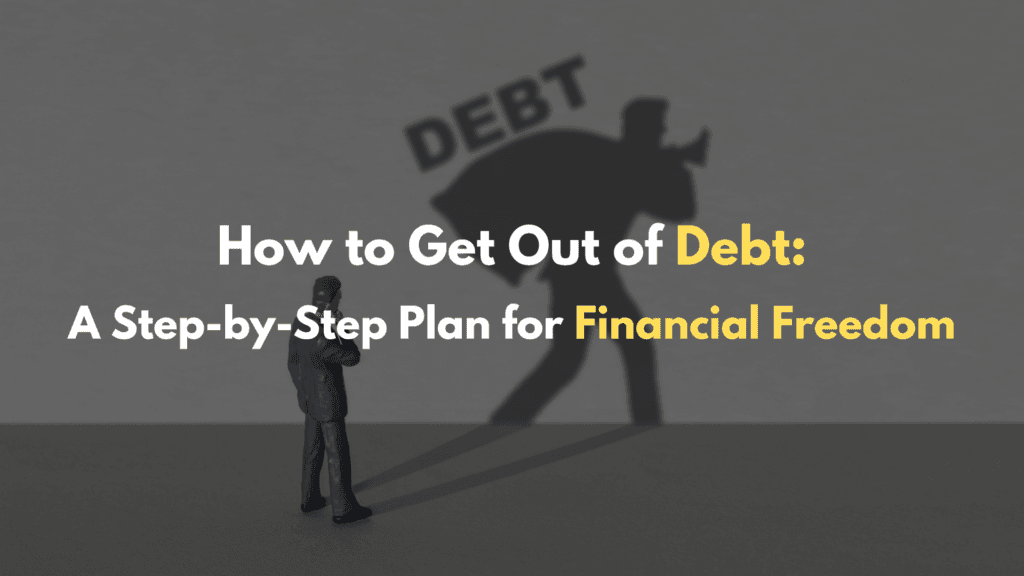Debt can feel like a heavy burden, weighing down your finances and your peace of mind. Whether it’s credit card debt, personal loans, student loans, or medical bills, the weight of unpaid debt can be overwhelming. However, the good news is that getting out of debt is not only possible, but it’s also achievable with the right plan and commitment.
In this article, we will provide a step-by-step guide to help you get out of debt and move towards financial freedom.
Step 1: Assess Your Current Financial Situation
Before you can start working on a debt repayment plan, it’s important to understand your current financial situation. This will give you a clear picture of your total debt, income, expenses, and where you stand financially.
How to Assess Your Situation:
- List All Your Debts: Write down each debt you owe, including the creditor, outstanding balance, interest rate, and monthly payment. Include credit cards, loans, mortgages, etc.
- Track Your Income and Expenses: Make a detailed list of your monthly income (salary, freelance income, etc.) and monthly expenses (rent, utilities, groceries, loan payments, etc.). This will help you understand how much you can afford to allocate toward paying off your debt.
- Check Your Credit Score: A credit score is a reflection of your creditworthiness. A higher credit score can help you secure lower interest rates in the future, but it can also highlight areas that need improvement.
Step 2: Create a Debt Repayment Strategy
Once you have a clear picture of your debt situation, it’s time to create a repayment strategy. There are a few popular methods to choose from, and each method has its own benefits. Select the one that works best for you:
1. The Debt Snowball Method
- How it works: Pay off your smallest debt first while making minimum payments on larger debts. Once the smallest debt is paid off, apply the amount you were paying on that debt toward the next smallest debt, and so on.
- Why it works: The debt snowball method can be motivating because you get quick wins. Paying off smaller debts quickly gives you a sense of accomplishment, which helps you stay motivated to continue.
2. The Debt Avalanche Method
- How it works: Focus on paying off the debt with the highest interest rate first while making minimum payments on other debts. Once the high-interest debt is paid off, move to the next highest interest rate, and so on.
- Why it works: The debt avalanche method saves you the most money in interest payments over time. Paying off high-interest debt first reduces the total amount of interest you’ll pay, allowing you to get out of debt faster.
3. The Debt Consolidation Method
- How it works: Consolidate all your debts into one loan with a lower interest rate. This can be done through a personal loan, a balance transfer credit card, or a home equity loan.
- Why it works: Debt consolidation simplifies your repayment process by reducing multiple payments to just one. It can also lower your interest rate, which could save you money in the long run.
Step 3: Cut Unnecessary Expenses and Increase Savings
Now that you have a strategy in place, it’s time to free up money for debt repayment. Cutting unnecessary expenses and redirecting those funds toward paying off your debt can make a significant difference.
Ways to Cut Back on Expenses:
- Review Your Spending: Look at your monthly expenses and identify areas where you can reduce or eliminate spending. For example, you might cancel subscription services you don’t use, cook more meals at home, or stop unnecessary shopping.
- Create a Budget: Use a budget to track your income and expenses. Stick to a budget to ensure you’re spending less than you earn and using any surplus to pay off your debt.
- Downsize or Share Expenses: If possible, consider downsizing your living arrangements or sharing costs with others (like a roommate) to save money.
- Automate Savings and Debt Payments: Set up automatic payments to ensure you never miss a due date, and automate a percentage of your income toward savings or debt repayment.
Step 4: Negotiate Lower Interest Rates or Repayment Terms
If you have high-interest credit card debt or loans, consider negotiating with your creditors for lower interest rates or better repayment terms. A lower interest rate means you can pay off your debt faster and with less financial strain.
How to Negotiate:
- Call Your Creditors: Reach out to your credit card companies or lenders and ask for a reduction in your interest rates or for a more manageable payment plan. Be polite but firm about your request.
- Consider Debt Settlement: If you’re struggling to make payments, some creditors may be willing to settle your debt for less than you owe, though this could impact your credit score.
- Explore Government Assistance Programs: In some cases, there are government programs or non-profit organizations that can help you manage your debt or reduce your interest rates.
Step 5: Avoid Taking on More Debt
It’s easy to fall back into the cycle of debt, especially if you continue to make purchases on credit. While you work on paying off your current debt, it’s essential to avoid taking on more debt.
Tips to Avoid Adding More Debt:
- Use Cash or Debit Cards: Avoid using credit cards unless absolutely necessary. Stick to paying with cash or debit cards to prevent racking up new debt.
- Save for Big Purchases: Instead of putting big expenses on credit, save up for them over time. This will prevent you from adding to your debt and will help you build a more sustainable financial future.
- Build an Emergency Fund: Having an emergency fund can prevent you from relying on credit when unexpected expenses arise. Aim to save 3-6 months’ worth of living expenses in a separate savings account.
Step 6: Stay Motivated and Track Your Progress
Getting out of debt takes time, so staying motivated throughout the process is key. Celebrate small victories and keep track of your progress to remind yourself of how far you’ve come.
How to Stay on Track:
- Set Milestones: Set specific, measurable goals for paying off different debts. For example, “Pay off ₹50,000 of my credit card debt in the next 6 months.”
- Track Your Progress: Use a spreadsheet or an app to track your progress toward becoming debt-free. Seeing your debt decrease over time will keep you motivated.
- Reward Yourself (Responsibly): Once you pay off a debt or hit a milestone, treat yourself to something small and meaningful. Just make sure that the reward doesn’t derail your progress.
Step 7: Seek Professional Help If Needed
If you’re overwhelmed by debt or unsure of how to proceed, seeking help from a financial advisor or credit counselor can provide clarity and guidance. A professional can help you create a tailored debt repayment plan, negotiate with creditors, or even help you consolidate your debt.
Conclusion
Getting out of debt is a journey, but with a clear plan and dedication, it is achievable. Start by assessing your situation, choosing a repayment strategy, cutting back on expenses, and staying disciplined with your payments. Avoiding new debt, staying motivated, and tracking your progress will keep you on the path toward financial freedom. Remember, financial freedom isn’t a destination; it’s a process, and with each step, you’re getting closer to a life free from debt. Stay focused and committed, and you’ll soon experience the peace of mind that comes with being debt-free.


